James Watt is a sixth-generation farmer from Templepatrick, Co Antrim, not far from Antrim city. Dairy farming is and has been the main enterprise through the generations of Watts. Today, James milks about 250 Holstein Friesian cows on a predominantly grass-based system.
Bedding between 450 and 500 round bales of straw annually, James looked into the option of a straw blower to curb the daily workload. “I took demonstration of a straw blower but the dust proved a major issue. It was no fault of that particular brand, just the nature of the straw blower concept given the way in which they chop and accelerate the straw. In my situation, keeping dust to a minimum was and remains critical as the freshly calved pen is under the same roof as the milking parlour,” James said.

The Spread-A-Bale works in a similar fashion to a rear discharge dung spreader.
Having scrapped that idea, James happened to stumble upon the Spread-A-Bale concept. “Given the way in which the Spread-A-Bale works (similar to a rear discharge spreader), it teases out the straw opposed to chopping and blowing it.”
Liking the idea, James bought the Spread-A-Bale Mini from Northern Irish dealer GA Allen. James said the Mini suited his situation best for its manoeuvrability around the yard compared to the larger Midi or Maxi models.
At 2.75m it’s one of the smallest models in the range which he feels is still quite long once combined with the length of his JCB telehandler when trying to navigate farm buildings.
Time savings
He took delivery of the new Spread-A-Bale Mini in 2020, and, approaching its third winter, James said it has brought about considerable time savings.
On average, the Spread-A-Bale has cut an hour of bedding each day. That adds up to a significant number of hours and expense if factoring in labour across a 12-month period.
He said: “Given that we calve cows 10 months of the year, there’s bedding to be done every day. We’d typically top up the calving pens, calf pens and freshly calved/sick pen with fresh straw little and often which totals to between 450 and 500 bales annually.
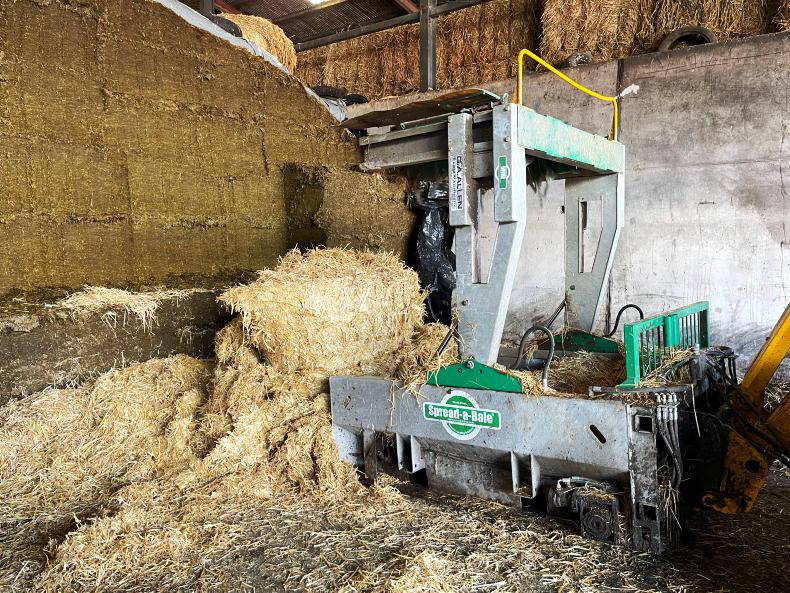
Once the rotors are raised up the unit is used to self load.
“Manually scattering out bales of straw was a job nobody liked doing. Everyone considered themselves busy when there was pens to be bedded,” James laughed.
The sheer workload was the main driving force behind the investment; safety too played a factor in the decision. “Cattle can get excitable when bedding, so if you can do it out of harm’s way, then all the better.
“There is a small reduction in the amount of straw being used, but not as much as I’d expect a straw blower to save. I find chopped straw works best through the machine providing it doesn’t have knives to chop material like a blower. That said, I have used un-chopped straw and it’s well able for it but chopped straw I find provides a more even coverage.
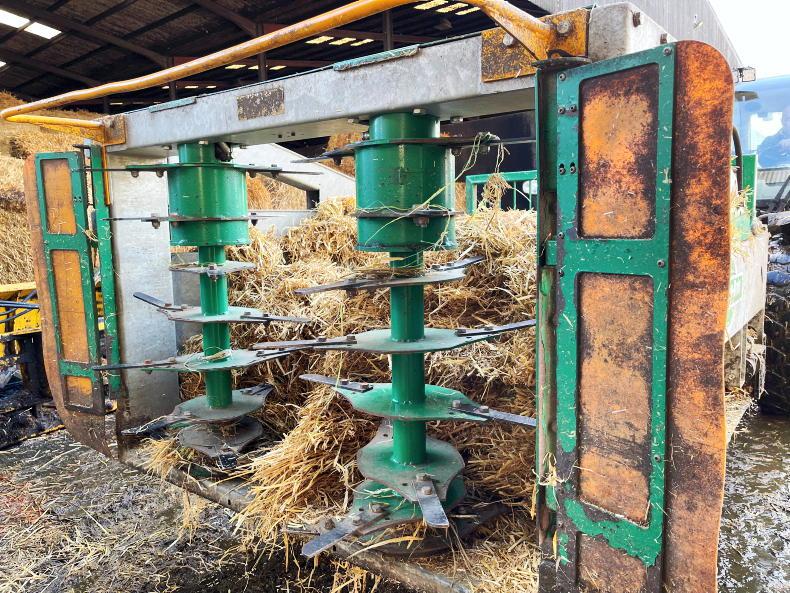
Two hydraulic rotors fitted with 16 flights each rotate outwards to spread the straw evenly.
“I bed with round bales 90% of the time. The Mini can handle bales up to 6ft in length which is really one round bale. That said, I have spread large square bales after removing a few flakes. In order for square bales to be spread well, it has to be good straw that wasn’t baled too damp. Damp straw tends to go fusty and can be very hard shook out by man or machine. In a situation like this the Spread-A-Bale can just fling the straw out in lumps,” James explained.
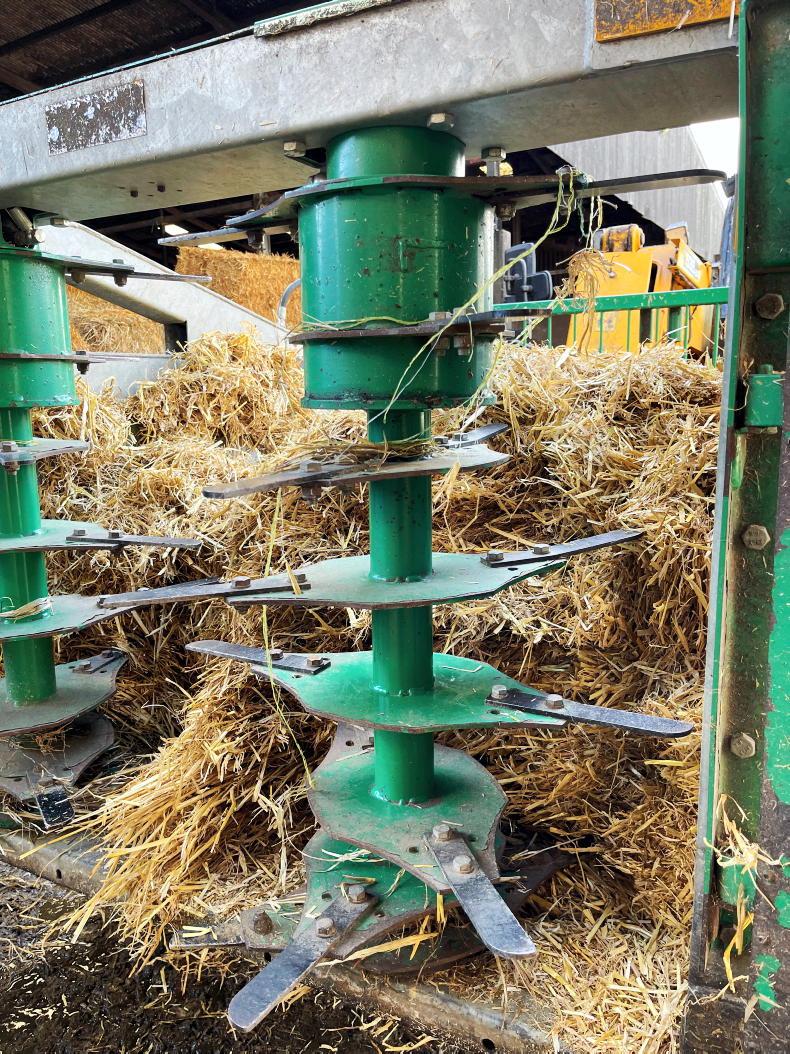
Each rotor is fitted with 16 bolt-on flights.
Another benefit according to James is that it doesn’t throw stones at the same speed that a blower would, protecting both livestock and the shed’s sheeting.
The workings
The Mini, as its name suggests, isone of the smaller machines in the Spread-A-Bale lineup, which extends to six ranges with 11 models in total. While there is a side throw version, models are predominantly the same in design and build aside from being lengthened for additional capacity.
Unlike the many straw blowers that double up as silage feeders, the Spread-A-Bale has only one main purpose – to spread straw bales.
Once net or string has been removed, the machine is self-loaded by pushing the bale against a wall or pit face in James’s case.
Keeping hydraulic requirements to a minimum, the Spread-A-Bale only requires one-third service with an oil flow of at least 55l/min. All moving parts including the floor, rotors and loading rams are hydraulically operated using a sequencing valve block. Therefore, in one direction the rotors raise, stop rotating and floor stops moving also. Then, in the other direction the opposite happens. The rotors are lowered, they begin to rotate and the floor beings to move again. At this point bedding has started.
Aside from using the third service switch to control oil flow and slow down or speed up rotor and floor speed, a manual flow control valve can be adjusted on the valve block to independently adjust floor speed, James pointed out.

The floor is driven via a hydraulic motor and gearbox.
Both of the outwards turning discharge rotors are driven via their own individual hydraulic motor and are supported at the opposite end via a carrier bearing. Each rotor has 16 bolt-on flights to help discharge the straw. On either side there are manually adjustable gates which, depending on their position, narrow or widen the spreading width which James says is a simple and effective solution. According to the manufacturer, the Mini has a spread width and distance range between 6m and 9m.
The rubber floor belt is driven via a maintenance-free hydraulic motor and gearbox. Optional extras for the Mini include a side frame for side mounting, loading and discharging, a lightweight frame for smaller loaders, HD motors for high-density bales and a Feed-A-Bale deflector kit for discharging into diet feeders.
James feels the machine is robust and strongly built from front to back. The main chassis of his machine is galvanised, but a painted finish is also available.

Manually adjustable doors provide some control over the spread width.
He noted that aside from straightening the very odd bent flight and greasing the rotor bearings, floor bearings and ram pins, maintenance is very low.
“I’m very happy having opted for the Spread-A-Bale. The fact it’s removed the painstaking job of manual shaking out up to 500 straw bales annually and not to mention the saving of an hour’s labour daily really justifies its existence,” said James.
“It’s a simple, robust machine that requires little maintenance which is a major benefit even after more than two years of daily use.
The only slight downside is that when loading bales, the third service has to be operated slowly so that the rotors don’t begin spinning.
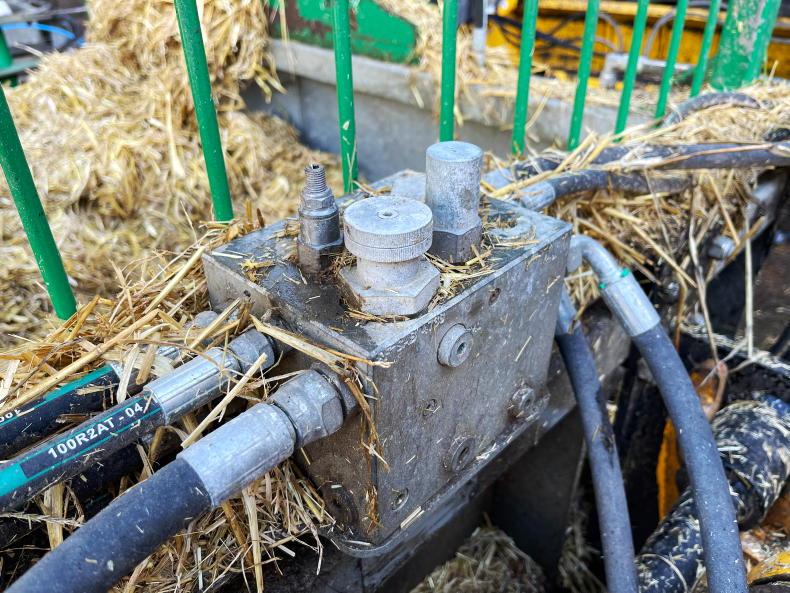
A manual flow control valve can be adjusted on the valve block to independently adjust floor speed.
“In hindsight, even if dust hadn’t have been an issue I think the Spread-A-Bale would still suit my needs better given that it’s a more simplistic machine compared to a straw blower. It worked out a cheaper alternative too.”
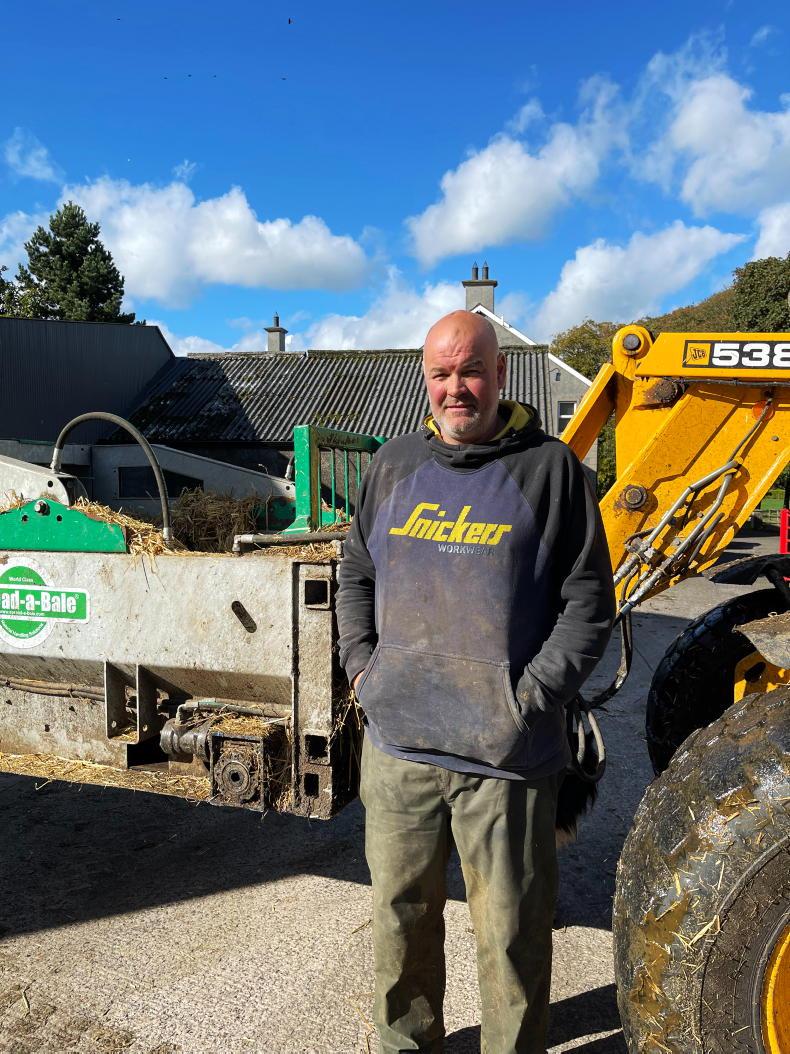
James Watt, Templepatrick, Co Antrim.
Model: Spread-A-Bale Mini.
Machine length: 2.75m.
Max bale dimensions: 1.94m (length) x 1.38 (width) x 1.55m (height).
Max bale weight:
350kg.
Unladen weight: 880kg.
Hydraulic requirement: 55l/min.
Discharge distance: 4.5m-9m.
List price as reviewed: €18,500 plus VAT.
James Watt is a sixth-generation farmer from Templepatrick, Co Antrim, not far from Antrim city. Dairy farming is and has been the main enterprise through the generations of Watts. Today, James milks about 250 Holstein Friesian cows on a predominantly grass-based system.
Bedding between 450 and 500 round bales of straw annually, James looked into the option of a straw blower to curb the daily workload. “I took demonstration of a straw blower but the dust proved a major issue. It was no fault of that particular brand, just the nature of the straw blower concept given the way in which they chop and accelerate the straw. In my situation, keeping dust to a minimum was and remains critical as the freshly calved pen is under the same roof as the milking parlour,” James said.

The Spread-A-Bale works in a similar fashion to a rear discharge dung spreader.
Having scrapped that idea, James happened to stumble upon the Spread-A-Bale concept. “Given the way in which the Spread-A-Bale works (similar to a rear discharge spreader), it teases out the straw opposed to chopping and blowing it.”
Liking the idea, James bought the Spread-A-Bale Mini from Northern Irish dealer GA Allen. James said the Mini suited his situation best for its manoeuvrability around the yard compared to the larger Midi or Maxi models.
At 2.75m it’s one of the smallest models in the range which he feels is still quite long once combined with the length of his JCB telehandler when trying to navigate farm buildings.
Time savings
He took delivery of the new Spread-A-Bale Mini in 2020, and, approaching its third winter, James said it has brought about considerable time savings.
On average, the Spread-A-Bale has cut an hour of bedding each day. That adds up to a significant number of hours and expense if factoring in labour across a 12-month period.
He said: “Given that we calve cows 10 months of the year, there’s bedding to be done every day. We’d typically top up the calving pens, calf pens and freshly calved/sick pen with fresh straw little and often which totals to between 450 and 500 bales annually.

Once the rotors are raised up the unit is used to self load.
“Manually scattering out bales of straw was a job nobody liked doing. Everyone considered themselves busy when there was pens to be bedded,” James laughed.
The sheer workload was the main driving force behind the investment; safety too played a factor in the decision. “Cattle can get excitable when bedding, so if you can do it out of harm’s way, then all the better.
“There is a small reduction in the amount of straw being used, but not as much as I’d expect a straw blower to save. I find chopped straw works best through the machine providing it doesn’t have knives to chop material like a blower. That said, I have used un-chopped straw and it’s well able for it but chopped straw I find provides a more even coverage.

Two hydraulic rotors fitted with 16 flights each rotate outwards to spread the straw evenly.
“I bed with round bales 90% of the time. The Mini can handle bales up to 6ft in length which is really one round bale. That said, I have spread large square bales after removing a few flakes. In order for square bales to be spread well, it has to be good straw that wasn’t baled too damp. Damp straw tends to go fusty and can be very hard shook out by man or machine. In a situation like this the Spread-A-Bale can just fling the straw out in lumps,” James explained.

Each rotor is fitted with 16 bolt-on flights.
Another benefit according to James is that it doesn’t throw stones at the same speed that a blower would, protecting both livestock and the shed’s sheeting.
The workings
The Mini, as its name suggests, isone of the smaller machines in the Spread-A-Bale lineup, which extends to six ranges with 11 models in total. While there is a side throw version, models are predominantly the same in design and build aside from being lengthened for additional capacity.
Unlike the many straw blowers that double up as silage feeders, the Spread-A-Bale has only one main purpose – to spread straw bales.
Once net or string has been removed, the machine is self-loaded by pushing the bale against a wall or pit face in James’s case.
Keeping hydraulic requirements to a minimum, the Spread-A-Bale only requires one-third service with an oil flow of at least 55l/min. All moving parts including the floor, rotors and loading rams are hydraulically operated using a sequencing valve block. Therefore, in one direction the rotors raise, stop rotating and floor stops moving also. Then, in the other direction the opposite happens. The rotors are lowered, they begin to rotate and the floor beings to move again. At this point bedding has started.
Aside from using the third service switch to control oil flow and slow down or speed up rotor and floor speed, a manual flow control valve can be adjusted on the valve block to independently adjust floor speed, James pointed out.

The floor is driven via a hydraulic motor and gearbox.
Both of the outwards turning discharge rotors are driven via their own individual hydraulic motor and are supported at the opposite end via a carrier bearing. Each rotor has 16 bolt-on flights to help discharge the straw. On either side there are manually adjustable gates which, depending on their position, narrow or widen the spreading width which James says is a simple and effective solution. According to the manufacturer, the Mini has a spread width and distance range between 6m and 9m.
The rubber floor belt is driven via a maintenance-free hydraulic motor and gearbox. Optional extras for the Mini include a side frame for side mounting, loading and discharging, a lightweight frame for smaller loaders, HD motors for high-density bales and a Feed-A-Bale deflector kit for discharging into diet feeders.
James feels the machine is robust and strongly built from front to back. The main chassis of his machine is galvanised, but a painted finish is also available.

Manually adjustable doors provide some control over the spread width.
He noted that aside from straightening the very odd bent flight and greasing the rotor bearings, floor bearings and ram pins, maintenance is very low.
“I’m very happy having opted for the Spread-A-Bale. The fact it’s removed the painstaking job of manual shaking out up to 500 straw bales annually and not to mention the saving of an hour’s labour daily really justifies its existence,” said James.
“It’s a simple, robust machine that requires little maintenance which is a major benefit even after more than two years of daily use.
The only slight downside is that when loading bales, the third service has to be operated slowly so that the rotors don’t begin spinning.

A manual flow control valve can be adjusted on the valve block to independently adjust floor speed.
“In hindsight, even if dust hadn’t have been an issue I think the Spread-A-Bale would still suit my needs better given that it’s a more simplistic machine compared to a straw blower. It worked out a cheaper alternative too.”

James Watt, Templepatrick, Co Antrim.
Model: Spread-A-Bale Mini.
Machine length: 2.75m.
Max bale dimensions: 1.94m (length) x 1.38 (width) x 1.55m (height).
Max bale weight:
350kg.
Unladen weight: 880kg.
Hydraulic requirement: 55l/min.
Discharge distance: 4.5m-9m.
List price as reviewed: €18,500 plus VAT.














 This is a subscriber-only article
This is a subscriber-only article










SHARING OPTIONS: